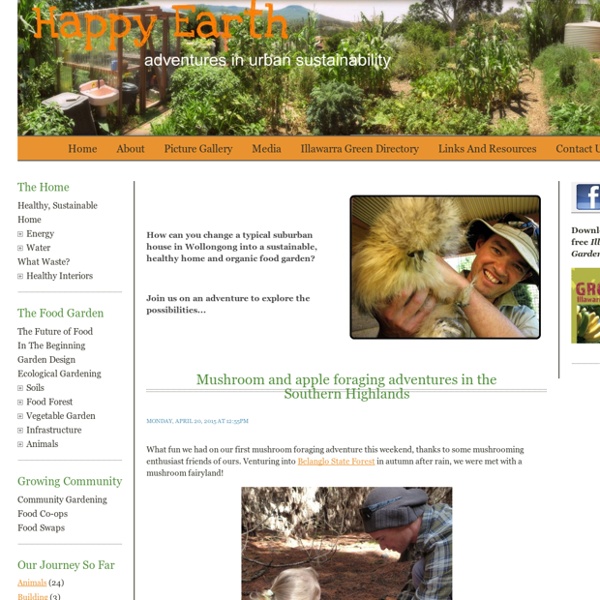



Permaculture shows us the path to a backyard revolution (NaturalNews) People nowadays are feeling like their lives are spinning out of control. They worry about being able to provide the necessities for their families as food and fuel prices soar and out of control inflation looms on the horizon. Many are almost totally disconnected from nature and that which sustains them. There is a rapidly growing and revolutionary worldwide movement of citizens taking steps that lead them out of dependence on the system and to a life of healthy re-connection and nourishment. This is the permaculture movement. There are many definitions for the holistic design system known as permaculture and the word itself derives from the combinations of permanent culture and permanent agriculture. The provision of food, shelter, water, energy and waste management are contained within permaculture design. Permaculture is the first design system in history to be based upon ethics.
CLIMA PREVISÃO CLIMÁTICA topo Estimativa do comportamento médio da atmosfera com antecedência de uma ou duas estações. Utilizam-se dois métodos: Método Estatístico: modelos de previsão empíricos, os quais se valem de uma correlação entre duas ou mais variáveis, para regionalmente estimar os prognósticos de uma delas.Método Dinâmico: modelos dinâmicos do sistema climático, nos quais se utiliza um conjunto de equações físicas que simulam os movimentos atmosféricos para prever os acontecimentos futuros. As regiões tropicais apresentam maior índice de acerto nas previsões, devido aos fatores que determinam os fenômenos meteorológicos, que são diretamente influenciados pelas condições da superfície (temperatura da superfície do mar e umidade do solos nos continentes). CONVENÇÃO – QUADRO DAS NAÇÕES UNIDAS SOBRE MUDANÇA DO CLIMA topo As correntes oceânicas e marítimas que cruzam o planeta, acionadas pela energia solar, moldam o ambiente. Alguns indícios de alteração do clima: PROTOCOLO DE QUIOTO topo Ver
Community Food Security Coalition - Publications Click below to jump to the following sections: CFSC E-NewsletterCFS ViewsCFSC HandoutsCFSC Guidebooks and ReportsHow to order CFSC Member E-Newsletter The CFSC Grapevine is a quarterly e-newsletter that provides our members with timely information about CFSC's programs and resources, and invites their input and participation. Each issue includes information on new publications, upcoming events, training and technical assistance opportunities, and profiles of member organizations. Issue 18, January 2012Issue 17, September 2011Issue 16, July 2011Issue 15, May 2011Issue 14, February 2011Issue 13, November 2010Issue 12, August 2010Issue 11, May 2010Issue 10, February 2010Issue 9, November 2009Issue 8, August 2009Issue 7, May 2009Issue 6, February 2009Issue 5, November 2008Issue 4, August 2008Issue 3, May 2008Issue 2, February 2008Issue 1, November 2007 From 2001-2008, CFSC published a print newsletter. To receive the current issue of the CFSC Grapevine e-newsletter, you must be a CFSC member.
Hungry for land: small farmers feed the world with less than a quarter of all farmland It is commonly heard today that small farmers produce most of the world's food. But how many of us realise that they are doing this with less than a quarter of the world's farmland, and that even this meagre share is shrinking fast? If small farmers continue to lose the very basis of their existence, the world will lose its capacity to feed itself. GRAIN took an in depth look at the data to see what is going on and the message is crystal clear. Download the PDF version of this report here Download the printer friendly dataset in PDF format here. Download the fully-referenced dataset as a spreadsheet here. Alcides Raméon Ramírez, a member of one of 200 peasant families fighting to defend their land in Curuguaty, Paraguay. Governments and international agencies frequently boast that small farmers control the largest share of the world's agricultural land. Rural people don't simply make a living off the land, after all. Then there is the other part of the picture: that concerning food. 1. 2.
DOMÍNIOS MORFOCLIMÁTICOS Introdução O Brasil, país tropical de grande extensão territorial, apresenta uma geografia marcada por grande diversidade. A interação e a interdependência entre os diversos elementos da paisagem (relevo, clima, vegetação, hidrografia, solo, fauna, etc.) explicam a existência dos chamados domínios geoecológicos, que podem ser entendidos como uma combinação ou síntese dos diversos elementos da natureza, individualizando uma determinada porção do território. Dessa maneira, podemos reconhecer, no Brasil, a existência de seis grandes paisagens naturais: Domínio Amazônico, Domínio das Caatingas, Domínio dos Cerrados, Domínio dos Mares de Morros, Domínio das Araucárias e Domínio das Pradarias. Entre os seis grandes domínios acima relacionados, inserem-se inúmeras faixas de transição, que apresentam elementos típicos de dois ou mais deles (Pantanal, Agreste, Cocais, etc.). Clima Relevo O relevo brasileiro é de formação antiga ou pré-cambriana , sendo erodido e, portanto, aplainado. Clima Equatorial
Permaculture Visions International Underground Farm Hiding 108 Feet Beneath London's Streets The story behind this farm is amazing, it’s placed 100 feet (33 meters) in an abandoned tube tunnel beneath the streets of Clapham, London. Using the latest hydroponic systems and LED technology, their crops can be grown year-round in the perfect, pesticide-free environment that these forgotten tunnels provide. Because they have total control over their environment, each tiny leaf tastes as amazing as the last and because they are unaffected by the weather and seasonal changes, they can reduce the need to import crops and drastically reduce the food miles for retailers and consumers. They pride themselves on being a carbon neutral company – The hydroponics system uses 70% less water than traditional open-field farming, and because all the nutrients are kept within the closed-loop system they run no risk of contributing to agricultural run-off. Their leaves can be in your kitchen within 4 hours of being picked and packed. They’re currently growing nine micro greens and three normal herbs.
Barrack Heights Community Garden